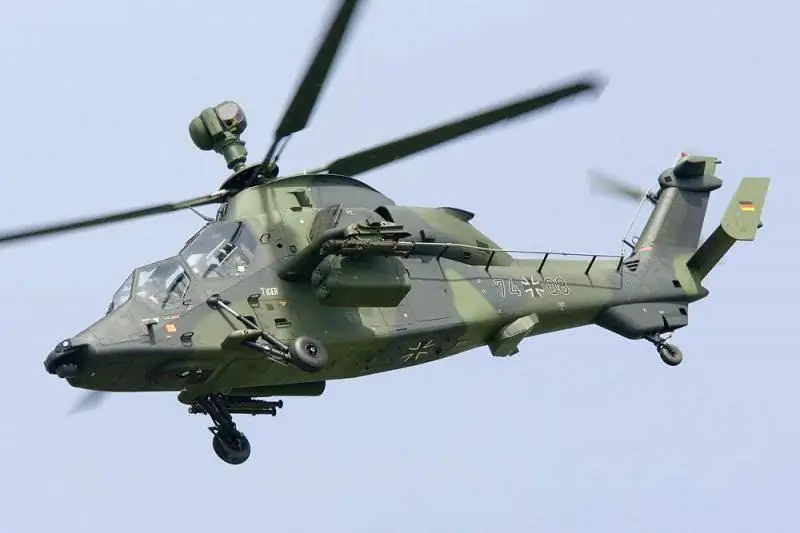- Author Matthew Elmers [email protected].
- Public 2023-12-16 21:49.
- Last modified 2025-01-24 09:17.

It is unlikely that thirty or forty years ago, someone could have imagined that the pavilions and parking areas of aviation salons would simply be packed with European technology. At that time, in full accordance with the political situation in the world, the leaders in this industry were the countries located "on the edges" of Europe - the USSR and the USA. However, due to a number of circumstances, relatively recently, in the 90s of the last century, European manufacturers of aviation equipment quickly took off.
The most developed helicopter manufacturers, namely Eurocopter (emerged as a result of the merger of the German Daimler-Benz Aerospace AG and the helicopter division of Aérospatiale) and AgustaWestland. They, of course, did not completely displace American and Soviet-Russian cars from the European market, but they took leading positions. So, over the past 15 years, the share of Americans from Bell in the European market has fallen by half to 14-15%.
As for the global figures, Eurocopter delivered almost 530 helicopters of various models to customers in 2010. Agusta's performance is more modest - only 171 helicopters sold. In percentage terms, only these two European firms provide equipment for more than 60% of the world helicopter market.
One of the main reasons for the success of European helicopters is the correct approach to product assignment. With a few exceptions (for example, the combat Eurocopter Tiger), European firms make multipurpose helicopters that are more promising in the market. For obvious reasons, such machines are bought not only by the military, but also by various other organizations, including commercial ones. It is worth mentioning the "branch" distribution of rotary-wing aircraft. Of the 8,700 helicopters in service in Europe last year, more than 3,600 were used as general-purpose vehicles, over 1,500 were in private or corporate use, and about 1,400 were operated as air taxis or charter flights. And only in fourth place were police helicopters - nearly nine hundred. Firefighters, medical and other "industries" are far behind in numbers. From these figures, the following conclusion can be drawn: commercial organizations have "tasted" the helicopter technology and appreciated its convenience. In the coming years, most likely, the number of cars in the most "popular" industries will continue to grow, and more actively than in others.
Although, sooner or later, the moment will come when potential buyers will have a significant number of even outdated, but not exhausted, machines. But even in this case, production is unlikely to drop significantly: some market saturation and a decrease in purchasing activity are already being observed. However, compared to the most successful year of the last decade, which was 2008, the drop in sales of the same Eurocopter does not look fatal - 588 units in 2008 versus 527 in 2010. But the above-described reduction applies more to private firms and organizations in which air travel plays a purely auxiliary role. But law enforcement agencies and emergency services, with all the peculiarities of their work, will constantly need to update the park, which only plays into the hands of "Agusta" and "Eurocopter". But this is only in theory. In practice, Spain, Portugal, and even more so Greece, are now not up to new helicopters, especially since the old ones have not yet developed a resource and are suitable for operation. According to manufacturers and banks, this situation should be corrected by special leasing offers, however, expectations may not come true.
If all financial tricks really do benefit the market, then the share of the world's helicopter fleet used in Europe could grow. Last year it was 20%. For comparison, a similar figure for the United States is 43%, and the closest pursuers of Europe in the person of Canada, the CIS and Australia operate only 6% of the total number of helicopters. In absolute numbers, as already mentioned, about 8,700 cars are used in Europe. Moreover, over ten years, the European fleet has increased by almost 3,100 helicopters, and this does not include the replacement of old ones. And most of the new cars that replaced the old ones, as is understandable, are of European origin.
Some optimism about growth comes from the fact that two-thirds of helicopters are operated in just five European countries (including Russia). Moreover, our country is in first place with almost 1800 helicopters. The top five are closed by 725 cars with German identification marks. Such an "unfair" distribution of helicopters in Europe could push countries from the bottom of the list to buy new machines. Although the same Cyprus, with its 21 helicopters, hardly needs new ones - there are 23 cars per million people, which is twice as many as in Russia or France. Although Cyprus is very far from Norway, where almost fifty helicopters go for the same million.
Summing up, we can say that in the quiet pool, which was the European helicopter industry thirty or forty years ago, hardened devils have grown, who have already grabbed two-thirds of the world market and, as practice shows, are not going to abandon them. Moreover, it is unlikely that Eurocopter or AgustaWestland are going to stop there. Therefore, if Bell, Sikorsky or Mil want, at least, to regain their former market share, then they will have to work seriously. Perhaps even in cooperation with the Europeans. Moreover, European helicopter companies have the entire set of infrastructure necessary for the full-fledged creation of helicopters with good commercial prospects.






